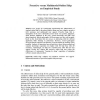Free Online Productivity Tools
i2Speak
i2Symbol
i2OCR
iTex2Img
iWeb2Print
iWeb2Shot
i2Type
iPdf2Split
iPdf2Merge
i2Bopomofo
i2Arabic
i2Style
i2Image
i2PDF
iLatex2Rtf
Sci2ools
AH
2008
Springer
2008
Springer
Proactive Versus Multimodal Online Help: An Empirical Study
Two groups of 8 participants experimented two enhancements of standard online help for the general public during one hour: adaptive proactive (AP) assistance and multimodal user support. Proactive help, that is, anticipation of the user’s information needs raised very positive judgments, while dynamic adaptation to the user’s current knowledge and skills went almost unnoticed. Speech and graphics (SG) messages were also well accepted, based on the observation that one can go on interacting with the software application while listening to instructions. However, several participants observed that the transience and linearity of speech limited the usability of this modality. Analysis of interaction logs and post-tests shows that procedural and semantic knowledge acquisition was higher with SG help than with AP assistance. Contrastingly, AP help was consulted more often than SG user support. Results also suggest that proactive online help may reduce the effectiveness of autonomous “l...
| Added | 01 Jun 2010 |
| Updated | 01 Jun 2010 |
| Type | Conference |
| Year | 2008 |
| Where | AH |
| Authors | Jérôme Simonin, Noëlle Carbonell |
Comments (0)

